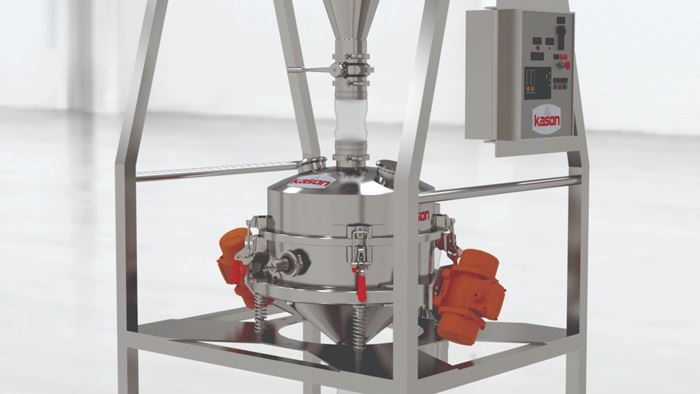Kason 3D-ReKlaimer Recovers Metal 3D Printing Powder
The self-contained metal powder reclamation system uses multi-plane, inertial vibration and ultrasonic frequencies to sift metal powders.
Kason’s dust-tight, fully automated 3D-ReKlaimer metal powder recovery system for 3D printing recovers and reconditions used powders to exacting particle sizes, reducing waste and lowering operating costs while preventing contamination of the product and plant environment. The system is offered in custom configurations to suit various additive manufacturing processes requirements.
A 24" (610-mm-diameter) Vibroscreen vibratory screener imparts multi-plane, inertial vibration that causes on-size metal powder particles to pass through apertures in the screen, and oversize particles to travel across the screen surface into a sealed container. A Kasonic ultrasonic anti-blinding device transmits ultrasonic frequencies to the screen, allowing sifting as fine as 25 microns/500 mesh with no screen blinding. The closed-loop system can be purged with inert gas to isolate contamination-sensitive powders from ambient air and moisture.
The unit can accept bottles of used powder connected manually, or through an optional integral vacuum conveying system that automatically transfers used powders from the build chamber into a filter receiver/hopper located above the screening chamber of the 3D-ReKlaimer system.
Similarly, screened powders ready for reuse can be discharged into bottles for manual connection to the inlet of 3D printers, or can be transferred automatically by an integral pneumatic conveyor that discharges into a filter receiver/hopper located above the 3D printer inlet.
The self-contained 3D-ReKlaimer system is ready to connect and run, and can serve multiple 3D printing stations when equipped with casters. Automated controls with an HMI simplify operation and minimize involvement of plant personnel. The unit’s stainless steel construction finished to sanitary standards eliminates dead spots, allowing total evacuation and easy cleaning. Optional HEPA filtration and ground resistance monitoring further enhances emission containment and operator safety.
Related Content
-
With Electrochemical Additive Manufacturing (ECAM), Cooling Technology Is Advancing by Degrees
San Diego-based Fabric8Labs is applying electroplating chemistries and DLP-style machines to 3D print cold plates for the semiconductor industry in pure copper. These complex geometries combined with the rise of liquid cooling systems promise significant improvements for thermal management.
-
This Year I Have Seen a Lot of AM for the Military — What Is Going On?
Audience members have similar questions. What is the Department of Defense’s interest in making hardware via 3D printing over conventional methods? Here are three manufacturing concerns that are particular to the military.
-
Additive Manufacturing Is Subtractive, Too: How CNC Machining Integrates With AM (Includes Video)
For Keselowski Advanced Manufacturing, succeeding with laser powder bed fusion as a production process means developing a machine shop that is responsive to, and moves at the pacing of, metal 3D printing.
















